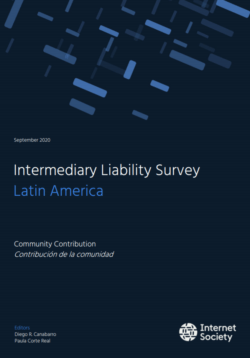Executive Summary
This report is a product of a crowdsourcing exercise designed to map current existing intermediary liability regimes in Latin American countries. Such an exercise was conducted with the full support of the Internet Society Community (chapter leaders and members) in the region. The process was developed in three stages: (1) a questionnaire (displayed in Annexes I and II) was generated in consultation with chapter leaders in April[1]; (2) all chapter leaders in Latin American countries were invited to respond but only one chapter met the deadline – May 30th; and (3) then the questionnaire was reopened to chapter members at-large until June 30th.
The questionnaire was responded 135 times, by people from 18 Latin American countries[2]: 105 respondents only added their names and contact information to the form; 22 responses provided partial answers; and 8 responses presented a more detailed description of rules and regulations that can affect intermediary liability in the following jurisdictions: Bolivia, Brazil, Colombia, Chile, the Dominican Republic, Ecuador, Mexico and Venezuela.
The eight country profiles presented in this report provide an up-to-date snapshot of the complex regulatory landscape that applies directly or indirectly to Internet intermediaries in some countries of Latin America. The majority of them still rely on more general administrative, civil and criminal norms that apply more or less uniformly to Internet intermediaries. Liability is generally associated with editorial behavior and copyright regimes are commonly applied (even if they do not have rules specific designed for Internet intermediary). General telecommunications regulations seem to be the common feature across the different countries surveyed, and Chile is a highlight due to its longstanding network neutrality rules that impose certain penalties for intermediaries who interfere with the free flow of data at the level of the infrastructure. Brazil is the only country among those listed below that has a specialized intermediary liability regime designed for Internet access providers and Internet application providers (which grants providers with certain degree of immunity in relation to third-party content.).
Additionally to that, the process helped us identify a group of people (bearing in mind those who provided partial & complete answers to the survey) that can be consulted and mobilized in the future for policy and community engagement as well as advocacy activities to promote and defend the importance of intermediary liability for the Internet Way of Networking. In order to achieve those goals, a suggested way forward might involve the formation of country/chapter-level specialized working groups to: a) review and expand the information comprised in individual country profiles generated during the first iteration of this exercise; b) receive additional training and work among themselves to inspire and collaborate with other chapters in the region; and c) be invited to develop additional activities and resources around the topic of intermediary liability in Q4.
An additional step to be taken can involve the replication of the process described above in other regions as a way of identifying other individuals and groups that can help the Internet Society increase its amount of information and knowledge about intermediary liability all over the World (leveraging our community to serve as a valuable source of input to other mapping exercises, such as Stanford’s University World Intermediary Liability Map).
Endnotes
[1] We are very thankful to Roberto Zambrana (ISOC Bolivia), German Fajardo (ISOC Colombia) and Flávio Wagner (ISOC Brasil) for their valuable support in the production of the questionnaire.
[2] Argentina, Bolívia, Brasil, Chile, Colombia, Costa Rica, Ecuador, El Salvador, Guatemala, Honduras, Mexico, Panama, Paraguay, Peru, Puerto Rico, República Dominicana, Uruguay, Venezuela.
